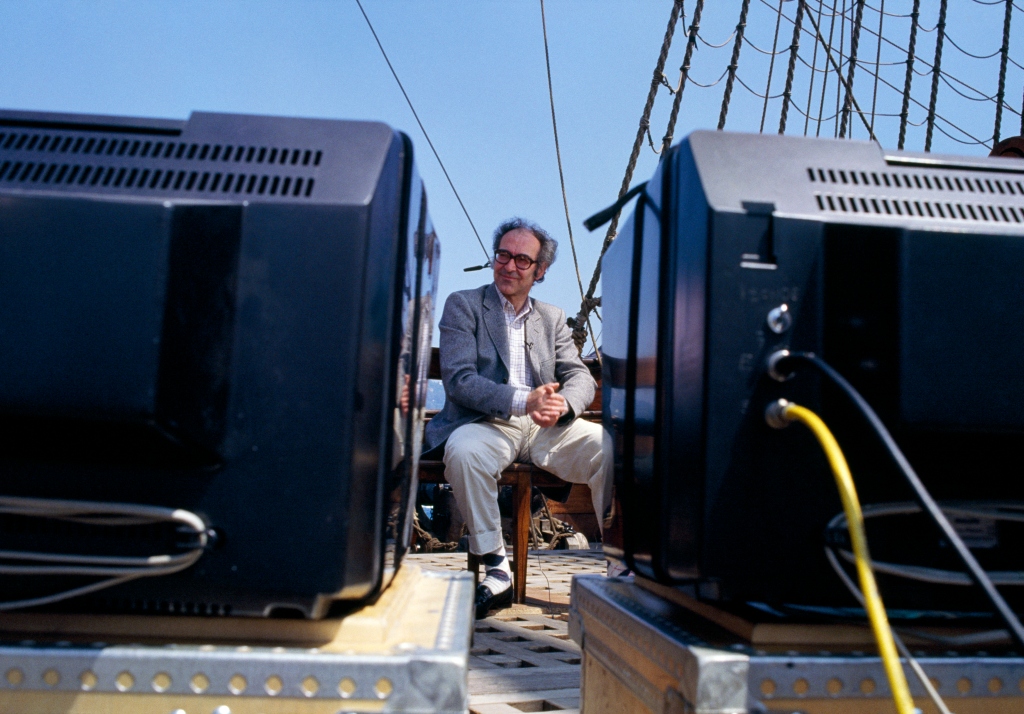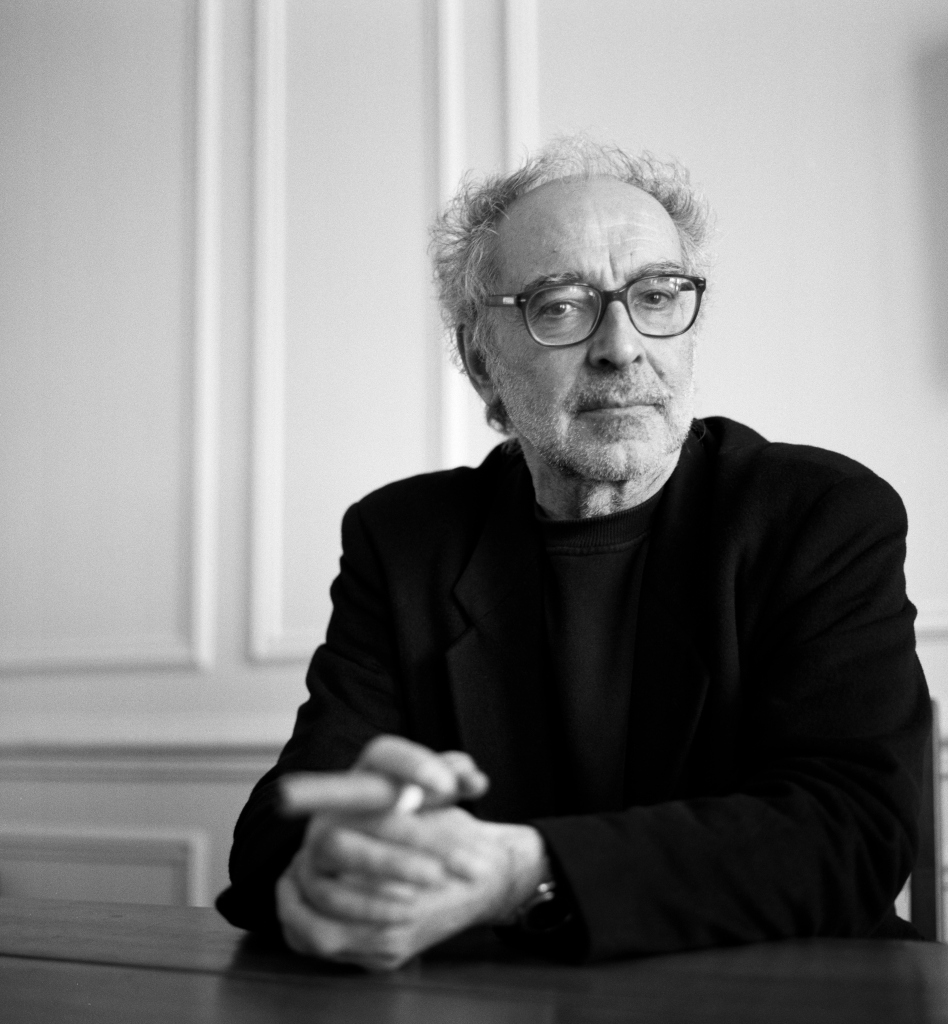Stubborn and iconoclastic as always, Jean-Luc Godard has passed to another realm–and by his own choice– at age 91. Ever-iconoclastic, impudent and exasperating, forever pushing boundaries but remaining elusive, and an artist in every fiber of his being, Godard always did exactly what he wanted to do; for a few years many followed him ardently, and for lots of us in the 1960s he led the way into a vastly exciting and personal form of cinema. Thereafter he went entirely his own way, losing most of his audience but remaining at the forefront of exploring what cinema is, could be, and, sometimes, what it absolutely shouldn’t be.
The official obituaries and tributes will certainly convey Godard’s importance and influence through the 1960s, the way he helped liberate cinema from its literary and orderly appearance to something far more energized, unexpected, jarring and often exhilarating. Although Godard consumed and brilliantly wrote about the existing cinema as a young critic, he never followed the accepted rules of the game creatively. Instead, he introduces jarring cuts, abrupt transitions, wild pursuits through city streets, spontaneous amorous escapades and an unending barrage of fresh ideas about how to put stories and characters on the screen in a vibrant real world, initially on the streets of Paris in Breathless.
Jean-Luc Godard Tributes Pour In From The World Of Cinema And Beyond: “National Treasure”
I was 17, a year away from college, when one Saturday afternoon I ventured to downtown Chicago’s immortal Clark Theater, where a ticket cost well under a dollar and featured what was called the “Little Gals’ Gallery,” a mezzanine reserved for women only (mostly middle-aged shoppers keen to take a load off their feet for a while) so that they would not be bothered by the sometimes shabby drunks and bums parked in the theater to sleep it off; every so often you’d hear a screech of alarm when some grungy guy in a long coat managed to sneak in upstairs. Scruffy it was, but the Clark had the best programming in town, a different double-bill every day of imaginatively but unpretentiously curated movies.
I’d heard exciting things about the two films I went to see, Breathless and Shoot the Piano Player. They were both in black-and-white, featured appealing, stylishly unkempt anti-heroes played by the ultra-cool Jean-Paul Belmondo and Charles Aznavour, respectively, and had a breezy, free-wheeling style to them the likes of which I’d never seen before, and certainly not in any Hollywood movies. I switched from studying Spanish to French at once.
These did not seem like “art” films; I’d seen a few other foreign-language films by that time, but they seemed rather fancy, or, if they were by Ingmar Bergman, quite austere, pretentious, even forbidding. By contrast, these French films were shot through with energy, made on the streets and with sexy but non-glamorized young performers who were unpredictable and seemed real. I was on board from day one.
In short order, I saw Godard’s other greatest films from the early to mid-1960s—Contempt, perhaps my favorite of all his films, an utterly precise and insightful work about the beginning of the end of a marriage which I always put on any ten-best-of-all-time lists; Band of Outsiders, Pierrot le Fou and Masculin-Feminin. These films significantly altered my way of looking at cinema surged with beauty and insights into art, impulsive romantic relationships and ways of seeing.
Take Two: Remembering Jean-Luc Godard; Venice, Toronto & Telluride Reactions Part I
The art/foreign-language film scene in major cities and at universities was exploding by the late ‘60s and early ‘70s, so it was possible to do almost everything if you were willing to sniff them out. By this time, Godard had fully entered his Maoist, hyper-revolutionary period, and I first met him when Tom Luddy, who was based in Berkeley and a few years later co-founded the Telluride Film Festival, was showing him around San Francisco. One of my worst memories of this period stemmed from taking a girlfriend to the Telegraph Theater in Berkeley to see some barely edited “revolutionary” footage that Godard had taken. It was all undigested, drearily monotonous political clap-trap that was stiflingly boring, but I stupidly insisted on seeing it out; our relationship was essentially dashed thanks to my Godardian completist mentality at that moment.
But my date absolutely had a valid point—even for the committed, it really was tough to sit through Godard’s agitprop, Maoist, story-free, “revolutionary” work from this period; and, despite his eventual quasi-return to “stories” later on, Godard never really regained his position among the top tier of international filmmakers, even as he continued to create at an astonishing rate.

More than anywhere in subsequent years, I saw Godard at Francis Coppola’s Zoetrope Studios, where he spent some significant time watching and experimenting with the electronic equipment Coppola was using during his flush post-Godfathers and Apocalypse Now period. Godard was fascinated with the technology Coppola was acquiring and planning to use in One From the Heart in 1980. He also became a huge fan of the Concorde, often flying from Paris to New York just to have lunch with a friend or to slightly quicken the trip to Los Angeles. And how many of you ever saw the utterly eccentric 1989 version of King Lear Godard made for none other than Menachem Golan; Norman Mailer was the original writer—I visited with him in San Francisco when he was working on it—and Peter Sellars and Tom Luddy ultimately saw it through.
Hollywood & Media Deaths 2022: A Photo Gallery
After a while, Godard definitively returned to Europe and continued to make films, albeit ones that only a limited number of people ever saw. The Cannes Film Festival dutifully premiered any film Godard offered to it in later years, and devotees continued to hope that, perhaps one day, he would make another “real” film along the lines of what he did in the 1960s. He did make some small beautiful films of a very personal kind once he retreated back to Switzerland, but I have no idea who or how many people actually ever saw them, other than in Cannes. Across about a decade in the 1990s, he also made the epic, eight-part Histoires du Cinema. In short, Godard had one of the most fecund minds and ever-busy careers in the history of cinema.
My dealings with him toward the end were not so pleasant. Years ago I made a documentary film about my close friend, the long-time cinematic eminence Pierre Rissient. Everyone I approached to be interviewed, including numerous very famous filmmakers, eagerly agreed—except for Godard. After repeatedly trying to get a response out of him in Switzerland, he finally replied with the following note: “I do not know nothing about Pierre Rissient.” This was a ridiculous reply on the face of it, as Rissient had been Godard’s assistant director on Breathless.
Much worse, however, was how he treated his longtime friend, Agnes Varda. As is documented in one of her last personal documentaries, Varda traveled to Switzerland to see Godard and presumably have a meal with him. But Godard refused to come to the door, leaving Varda hanging out to dry after a long trip. Nonetheless, she left a bag of brioche for him on his door.

